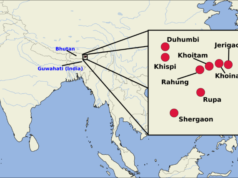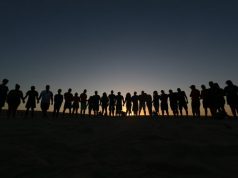Our ability to recognize faces is a complex interplay of neurobiology, environment and contextual cues.
Now a study from Harvard Medical School suggests that country-to-country variations in sociocultural dynamics—notably the degree of gender equality—can yield marked differences in men’s and women’s ability to recognize famous faces.
The findings, published Nov. 29 in Scientific Reports, reveal that men living in countries with high gender equality—Scandinavian and certain Northern European nations—perform nearly as well as women in accurately identifying the faces of female celebrities. Men living in countries with lower gender equality, such as India or Pakistan for example, fare worse than both their Scandinavian peers and women in their own country in recognizing female celebrities. U.S. males, the study found, fall somewhere in between, a finding that aligns closely with United States’ mid-range score on international metrics of gender equality.
The results are based on scores from web-based facial recognition tests of nearly 3,000 participants from the United States and eight other countries and suggest that sociocultural factors can shape the ability to discern individual characteristics over broad categories. They suggest that men living in countries with low gender equality are prone to cognitive “lumping” that obscures individual differences when it comes to recognizing female faces.
“Our study suggests that whom we pay attention to appears to be, at least in part, fueled by our culture, and how and whom we choose to categorize varies by the sociocultural context we live in.” said study senior investigator Joseph DeGutis, Harvard Medical School assistant professor of psychiatry and a researcher at VA Boston Healthcare System.
Find your dream job in the space industry. Check our Space Job Board »
“Our findings underscore how important social and cultural factors are in shaping our cognition and in influencing whom we recognize and whom we do not,” said study first author Maruti Mishra, Harvard Medical School research fellow in psychiatry in DeGutis’s lab. “Culture and society have the power to shape how we see the world.”
The team’s findings showed that men living in the United States—a country that ranks midrange on the United Nations’ Gender Inequality Index—performed better when asked to identify famous male politicians, actors or athletes than when they were asked to identify famous female politicians, actors or athletes. And they fared worse than women in identifying famous female celebrities. Men from Scandinavian countries, such as Norway, Denmark and Finland—all places with a high level of gender equality—performed equally well in recognizing famous male faces and famous female faces. On the other hand, men living in countries with low gender equality—India, Brazil and Pakistan, among others—performed worse than U.S. men and worse still than Scandinavian men in identifying famous women.
The Gender Inequality Index measures the level of a country’s gender inequality by taking into account things like the status of women’s reproductive health, education, economic status, and participation and attainment of high-level positions in the workforce. The algorithm scored the United States in the mid-range in 2014-2015 with a score of 0.21—a higher score denotes greater degree of gender inequality—compared with 0.05 for Scandinavian countries, and 0.49 for countries such as India, Pakistan or Egypt.
Famous faces
For the study, the researchers asked nearly 2,773 adults, ages 18 to 50, to look at a series of famous faces online and identify them. Participants included 2,295 U.S. men and women; 203 men and women from Denmark, the Netherlands, Finland and Norway; and 275 men and women from India, Egypt, Brazil, Pakistan and Indonesia. The celebrity faces were almost exclusively those of U.S. politicians, actors, athletes and performers. The researchers point out that the faces shown were exclusively those of U.S. celebrities. To ensure that U.S. participants didn’t have unfair advantage in facial familiarity over their foreign peers, the researchers only analyzed results from international participants who had indicated they were familiar with or had seen the celebrities’ faces before.
Overall, male celebrity faces were better recognized than female celebrity faces by both men and women, regardless of where they lived. On average, male faces were recognized with 8 percent greater accuracy than female faces. The one notable exception were women from countries with lower gender equality, who performed better at identifying female celebrities than at identifying male celebrities.
But the truly intriguing differences emerged when researchers analyzed the accuracy of recognizing famous female celebrities by participant gender.
In the U.S. sample, female participants had, on average, 7 percent more accurate scores than their male counterparts in recognizing the faces of famous women. Gender differences were also pronounced among participants from Pakistan, India, Brazil and Egypt. In those countries, women scored, on average 10 percent higher on female celebrity recognition than men. In contrast, test score differences in recognizing famous women’s faces were minuscule (less than 2 percent difference) among participants from the Netherlands, Norway, Finland and Denmark.
The researchers say the pronounced own-gender bias among males—the tendency to recognize more accurately famous male over famous female faces —is a variation of other forms of perceptual bias that have been documented in past research. For example, research shows that people tend to overlook interpersonal variations in the faces of people from races that differ from their own—the so-called “other race” effect. Another manifestation of this tendency is the bias toward noticing the interpersonal variations in individuals who are higher on the workplace hierarchy but obscuring interpersonal differences among those who rank lower on work totem pole. The classic example would be forgetting the name or other individual characteristics of a lower-rung coworker or an intern but remembering the name or distinguishing characteristics of someone higher up.
“All these biases stem from a tendency to categorize rather than individualize,” DeGutis said.
Self-awareness is the first step to combating own-gender bias, the researchers said. For example, previous research into the other-race effect suggests that practicing to individualize members of other racial groups rather than lump them into categories can seriously mitigate the other-race effect.
“Own-gender bias is a form of unconscious bias,” DeGutis said. “But by becoming aware of it, we can overcome it or at least minimize it.”
The researchers acknowledge the study has a few limitations, including the use of binary gender designations rather than a continuous gender spectrum.
Provided by: Harvard Medical School
More information: Maruti V. Mishra et al. Gender Differences in Familiar Face Recognition and the Influence of Sociocultural Gender Inequality. Scientific Reports (2019). DOI: 10.1038/s41598-019-54074-5
Rankin W. McGugin et al. Race-Specific Perceptual Discrimination Improvement Following Short Individuation Training With Faces. Cognitive Science (2010). DOI: 10.1111/j.1551-6709.2010.01148.x
Image Credit: CC0 Public Domain











